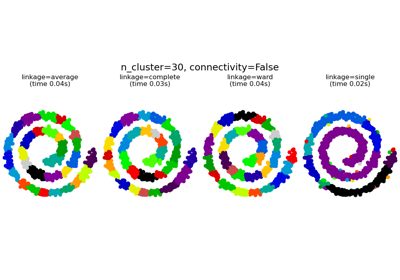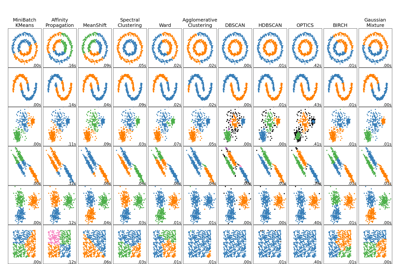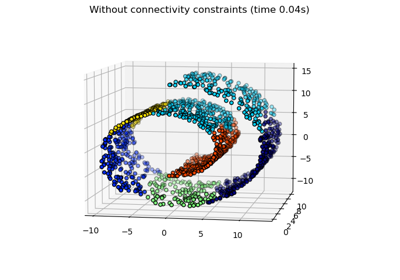W3cubDocs
/scikit-learnsklearn.neighbors.kneighbors_graph
-
sklearn.neighbors.kneighbors_graph(X, n_neighbors, mode='connectivity', metric='minkowski', p=2, metric_params=None, include_self=False, n_jobs=1)[source] -
Computes the (weighted) graph of k-Neighbors for points in X
Read more in the User Guide.
Parameters: X : array-like or BallTree, shape = [n_samples, n_features]
Sample data, in the form of a numpy array or a precomputed
BallTree.n_neighbors : int
Number of neighbors for each sample.
mode : {‘connectivity’, ‘distance’}, optional
Type of returned matrix: ‘connectivity’ will return the connectivity matrix with ones and zeros, and ‘distance’ will return the distances between neighbors according to the given metric.
metric : string, default ‘minkowski’
The distance metric used to calculate the k-Neighbors for each sample point. The DistanceMetric class gives a list of available metrics. The default distance is ‘euclidean’ (‘minkowski’ metric with the p param equal to 2.)
include_self: bool, default=False. :
Whether or not to mark each sample as the first nearest neighbor to itself. If
None, then True is used for mode=’connectivity’ and False for mode=’distance’ as this will preserve backwards compatibilty.p : int, default 2
Power parameter for the Minkowski metric. When p = 1, this is equivalent to using manhattan_distance (l1), and euclidean_distance (l2) for p = 2. For arbitrary p, minkowski_distance (l_p) is used.
metric_params: dict, optional :
additional keyword arguments for the metric function.
n_jobs : int, optional (default = 1)
The number of parallel jobs to run for neighbors search. If
-1, then the number of jobs is set to the number of CPU cores.Returns: A : sparse matrix in CSR format, shape = [n_samples, n_samples]
A[i, j] is assigned the weight of edge that connects i to j.
See also
Examples
>>> X = [[0], [3], [1]] >>> from sklearn.neighbors import kneighbors_graph >>> A = kneighbors_graph(X, 2, mode='connectivity', include_self=True) >>> A.toarray() array([[ 1., 0., 1.], [ 0., 1., 1.], [ 1., 0., 1.]])
Examples using sklearn.neighbors.kneighbors_graph
© 2007–2016 The scikit-learn developers
Licensed under the 3-clause BSD License.
http://scikit-learn.org/stable/modules/generated/sklearn.neighbors.kneighbors_graph.html


